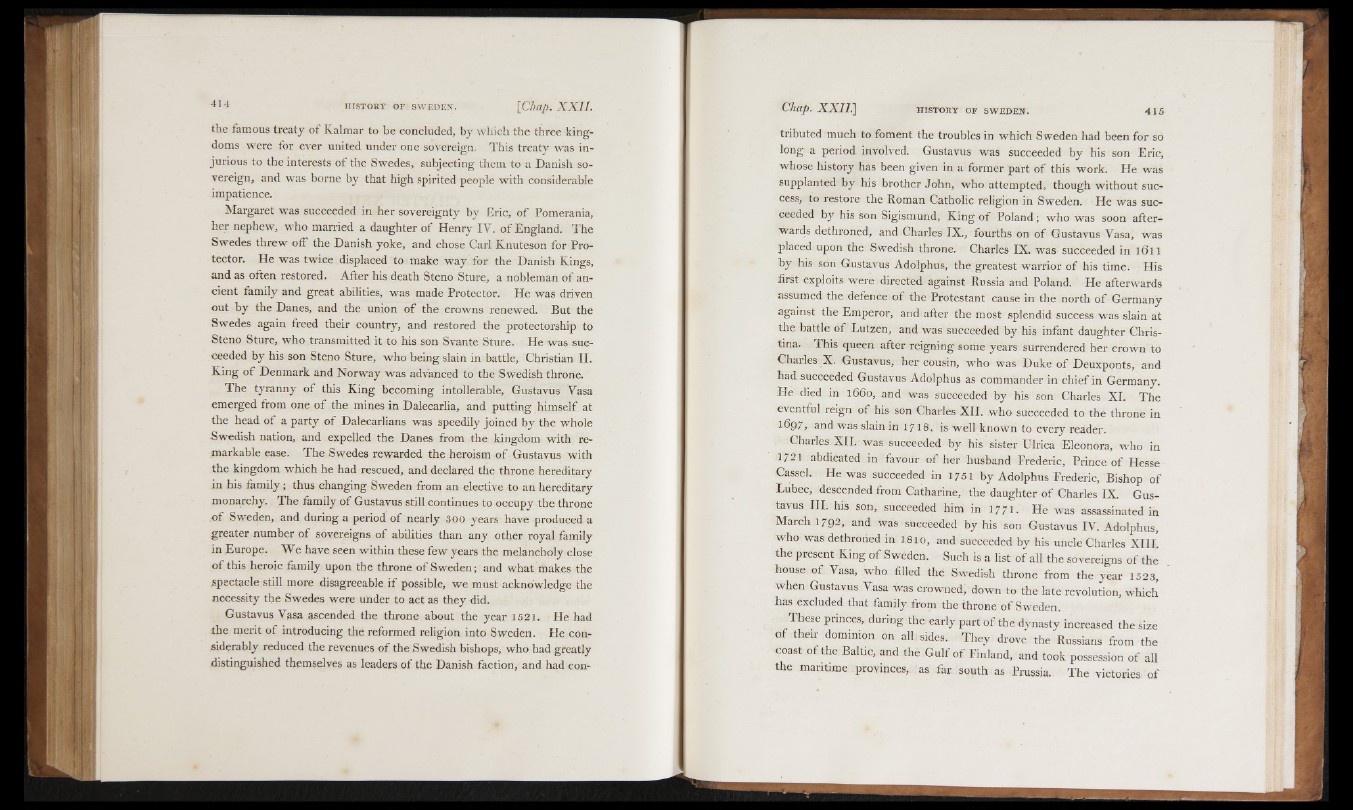
the famous treaty o f Kalmar to be concluded, by which the three kingdoms
were for ever united under one sovereign. This treaty was injurious
to the interests of the Swedes, subjecting them to a Danish sovereign,
and was borne by that high spirited people with considerable
impatience.
Margaret was succeeded in her sovereignty by Eric, of Pomerania,
her nephew, who married a daughter of Henry IY. o f England. The
Swedes threw off the Danish yoke, and chose Carl Knuteson for Protector.
He was twice displaced to make way for the Danish Kings,
and as often restored. After his death Steno Sture, a nobleman of ancient
family and great abilities, was made Protector. He was driven
out by the Danes, and the union of the crowns renewed. But the
Swedes again freed their country, and restored the protectorship to
Steno Sture, who transmitted it to his son Svante Sture. He was succeeded
by his son Steno Sture, who being slain in battle, Christian II.
King of Denmark and Norway was advanced to the Swedish throne.
The tyranny o f this King becoming intollerable, Gustavus Yasa
emerged from one o f the mines in Dalecarlia, and putting himself at
the head o f a party o f Dalecarlians was speedily joined by the whole
Swedish nation, and expelled the Danes from the kingdom with remarkable
ease. The Swedes rewarded the heroism o f Gustavus with
the kingdom which he had rescued, and declared the throne hereditary
in his family; thus changing Sweden from an elective to an hereditary
monarchy. The family o f Gustavus still continues to occupy the throne
o f Sweden, and during a period o f nearly 300 years have produced a
greater number of sovereigns o f abilities than any other royal family
in Europe. We have seen within these few years the melancholy close
o f this heroic family upon the throne o f Sweden; and what makes the
spectacle still more disagreeable i f possible, we must acknowledge the
necessity the Swedes were under to act as they did.
Gustavus Vasa ascended the throne about the year 1521. He had
the merit of introducing the reformed religion into Sweden. He considerably
reduced the revenues of the Swedish bishops, who had greatly
distinguished themselves as leaders of the Danish faction, and had contributed
much to foment the troubles in which Sweden had been for so
long a period involved. Gustavus was succeeded by his son Erie,
whose history has been given in a former part of this work. He was
supplanted by his brother John, who attempted, though without success,
to restore the Roman Catholic religion in Sweden. He was succeeded
by his son Sigismund, King o f Poland; who was soon afterwards
dethroned, and Charles IX., fourths on o f Gustavus Yasa, was
placed upon the Swedish throne. Charles IX. was succeeded in l 6 l l
by his son Gustavus Adolphus, the greatest warrior of his time. His
first exploits were directed against Russia and Poland. He afterwards
assumed the defence o f the Protestant cause in the north of Germany
against the Emperor, and after the most splendid success was slain at
the battle of Lutzen, and was succeeded by his infant daughter Christina.
This queen after reigning some years surrendered her erown to
Charles X. Gustavus, her cousin, who was Duke o f Deuxponts, and
had succeeded Gustavus Adolphus as commander in chief in Germany.
He died in 1660, and was succeeded by his son Charles XI. The
eventful reign of his son Charles XII. who succeeded to the throne in
1697* and was slain in 1718, is well known to every reader.
Charles XII. was succeeded by his sister Ulrica Eleonora, who in
1721 abdicated in favour o f her husband Frederic, Prince o f Hesse
Cassel. He was succeeded in 1751 by Adolphus Frederic, Bishop o f
Lubec, descended from Catharine, the daughter o f Charles IX. Gustavus
III. his son, succeeded him in 1771. He was assassinated in
March 1792, and was succeeded by his son Gustavus IV. Adolphus,
who was dethroned in J.810, and succeeded by his uncle Charl y XIII.
the present King o f Sweden. Such is a list of all the sovereigns o f the
house o f Vasa, who filled thé Swedish throne from the year 1523,
when Gustavus Vasa was crowned) down to the late revolution, which
has excluded that family, from the throne of Sweden.
These princes, during the early part o f the dynasty increased the size
o f their dominion on all; sides. They drove the Russians from the
coast of the Baltic, and the Gulf o f Finland, and took possession o f all
the maritime provinces,, as far. south as Prussia. The victories- o f